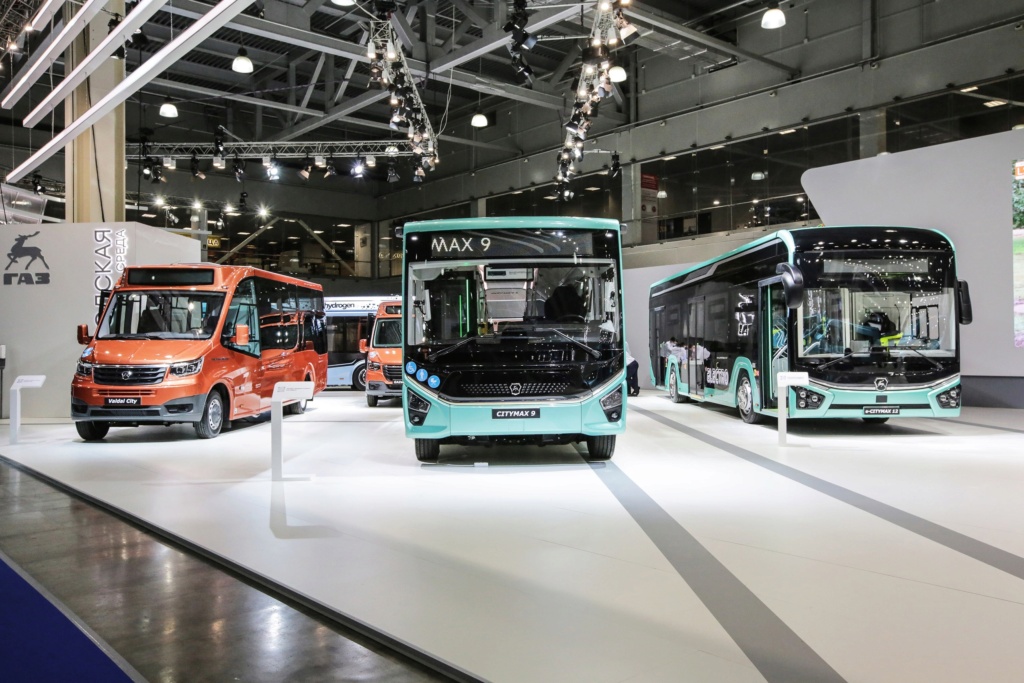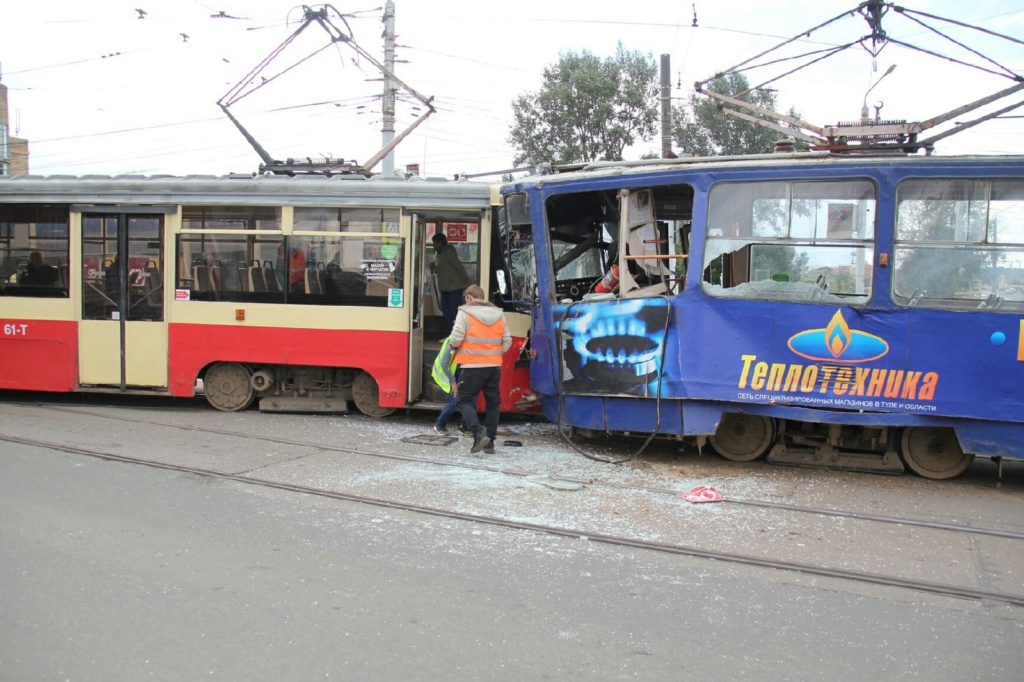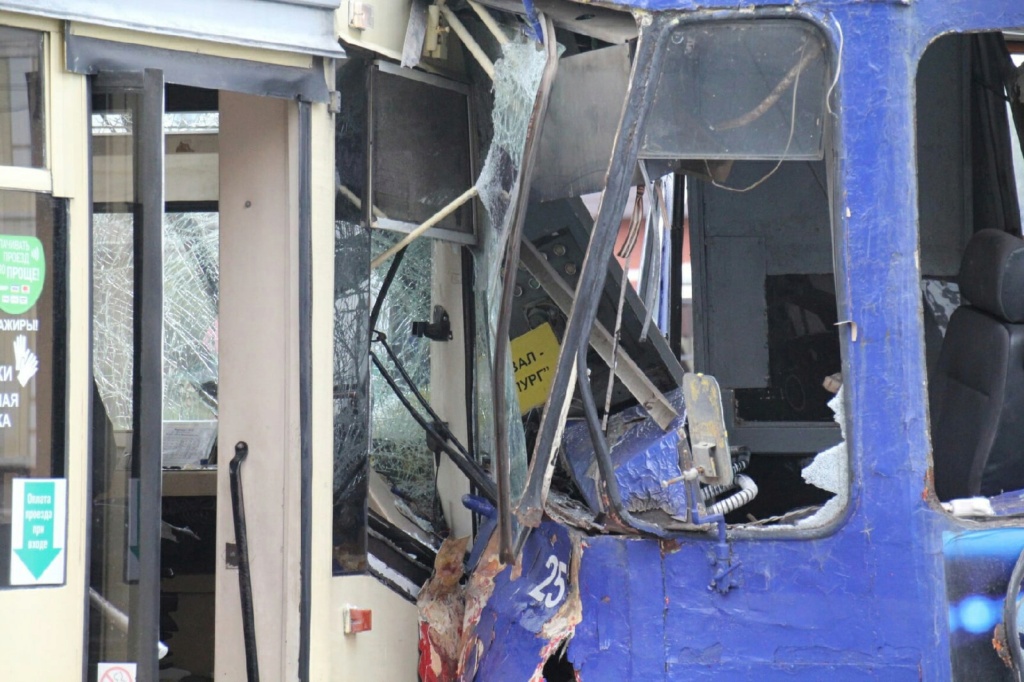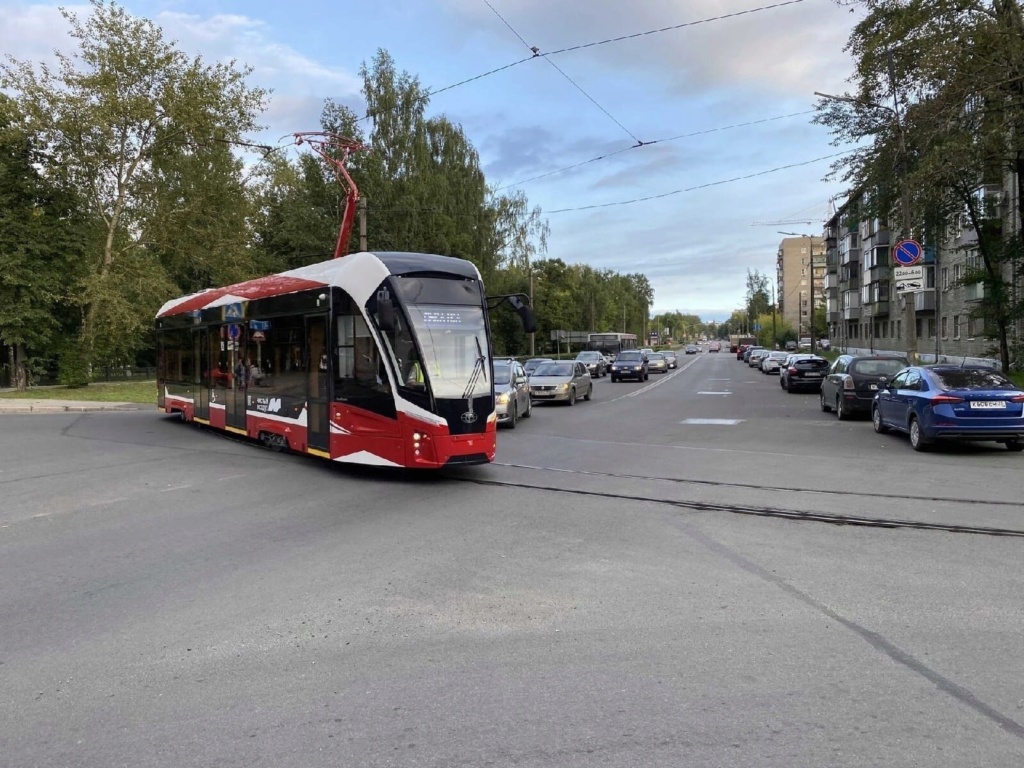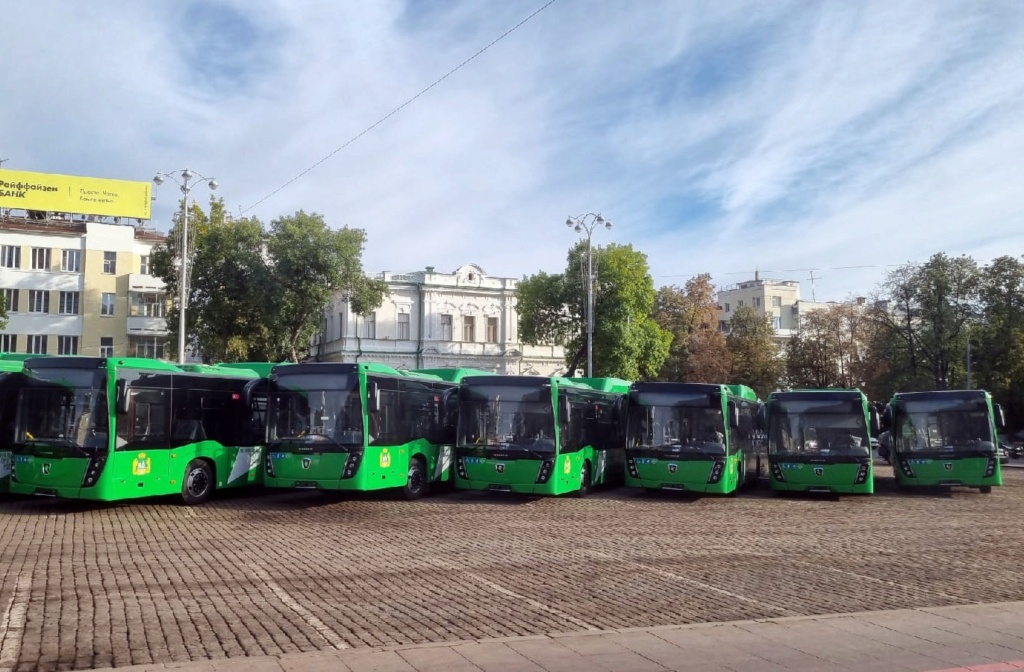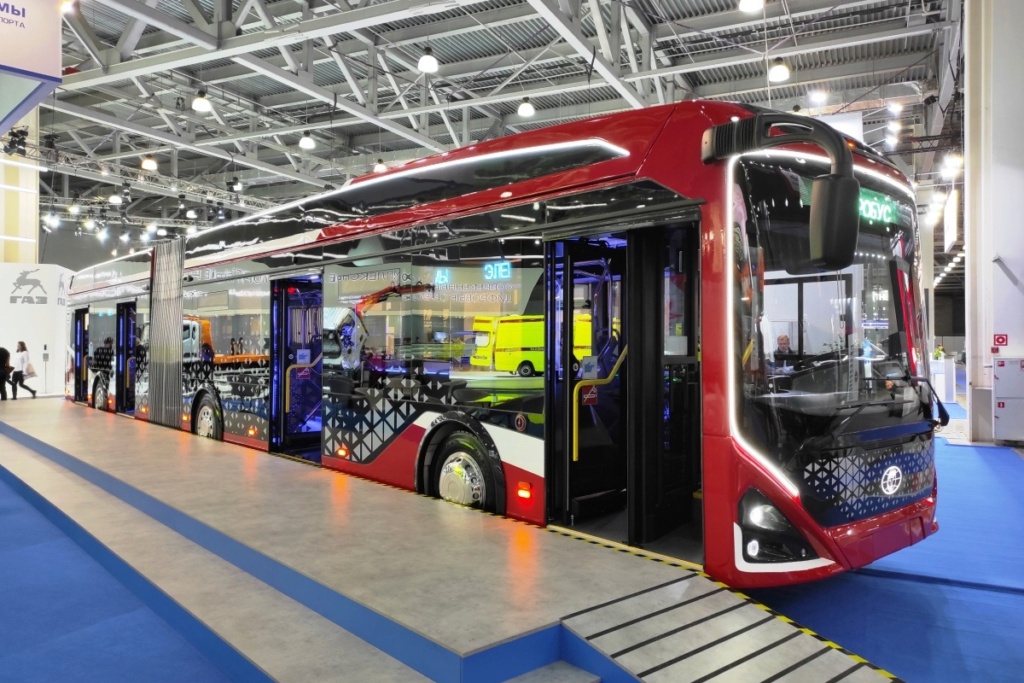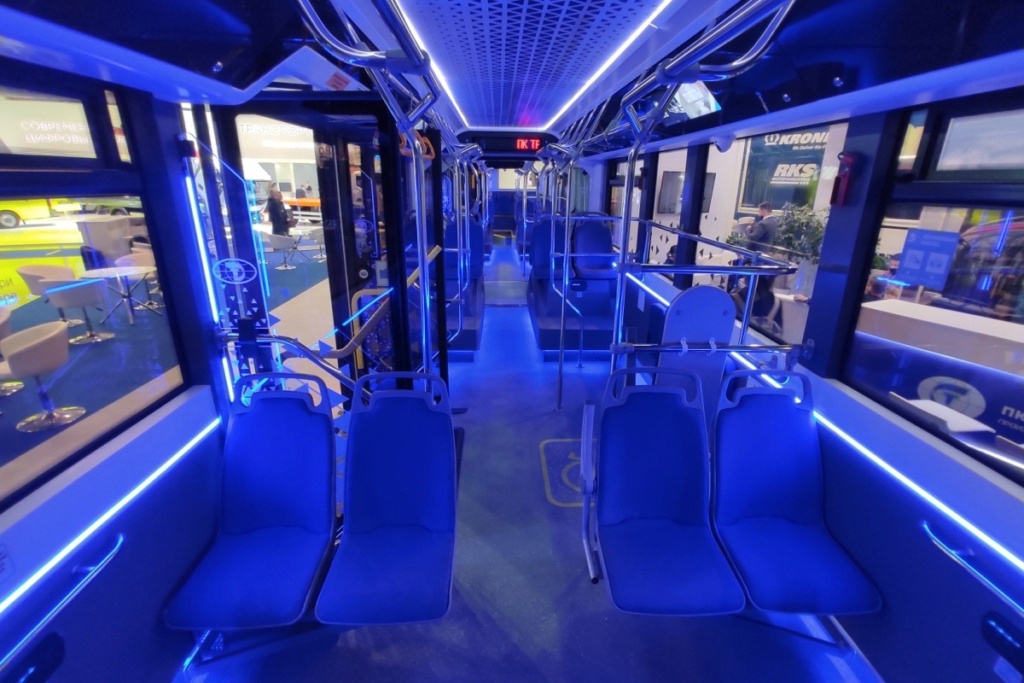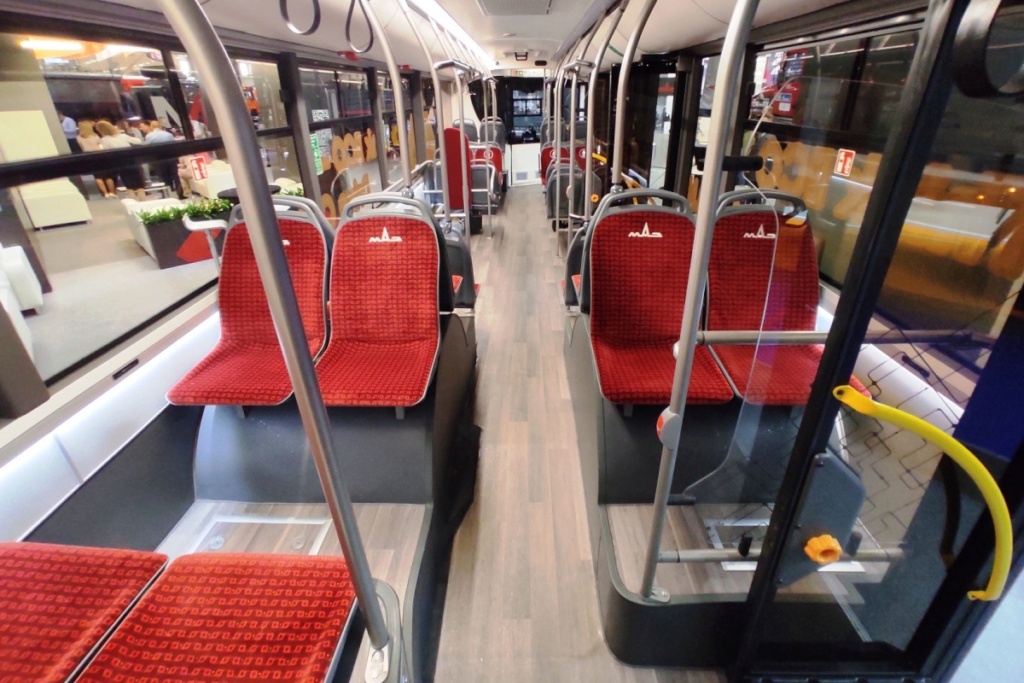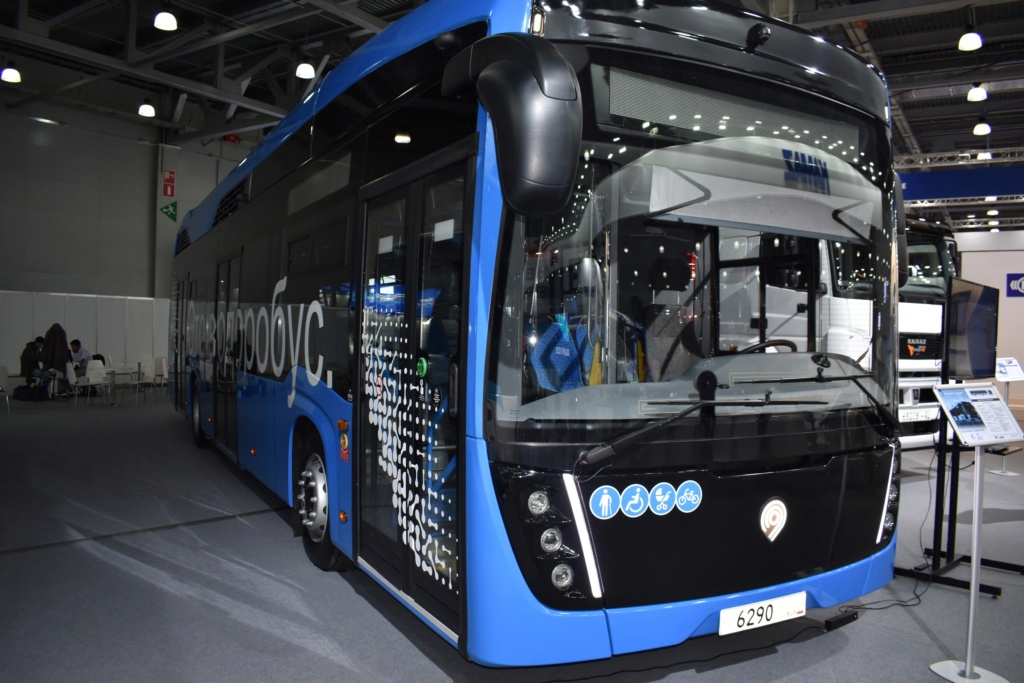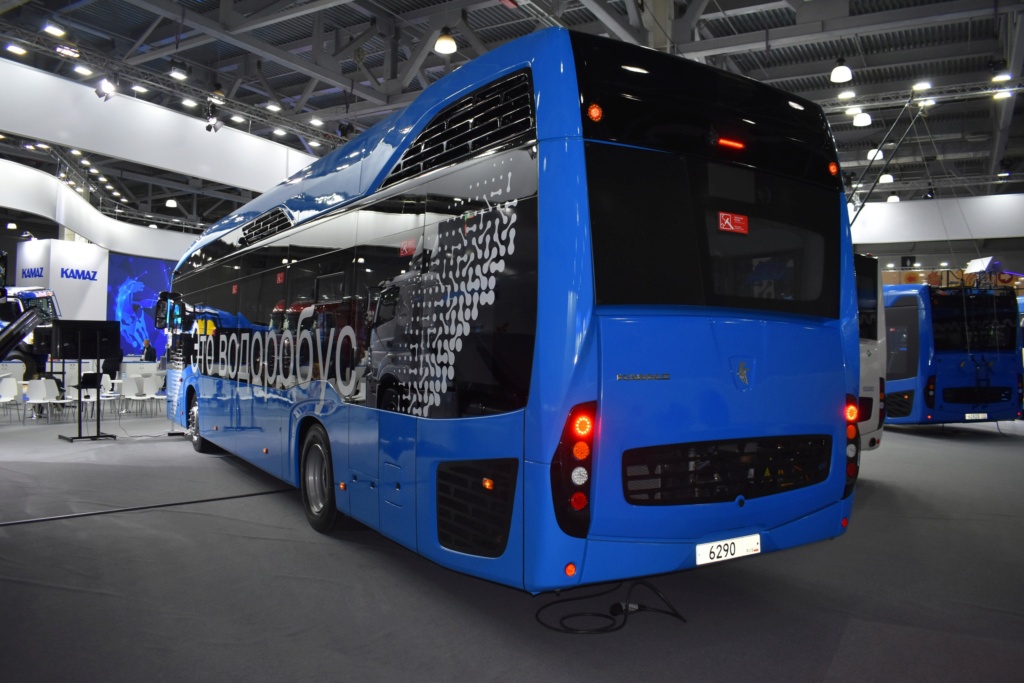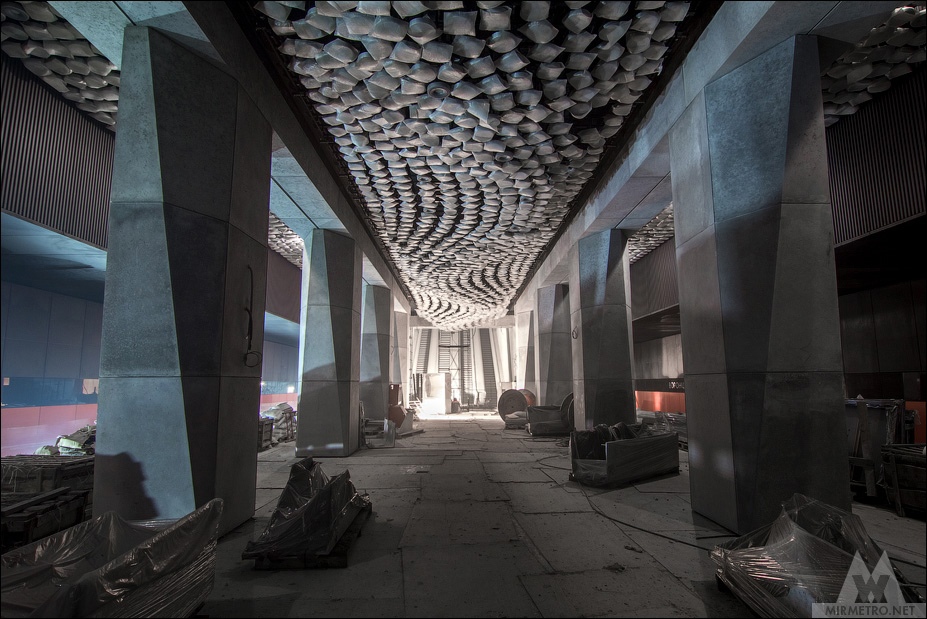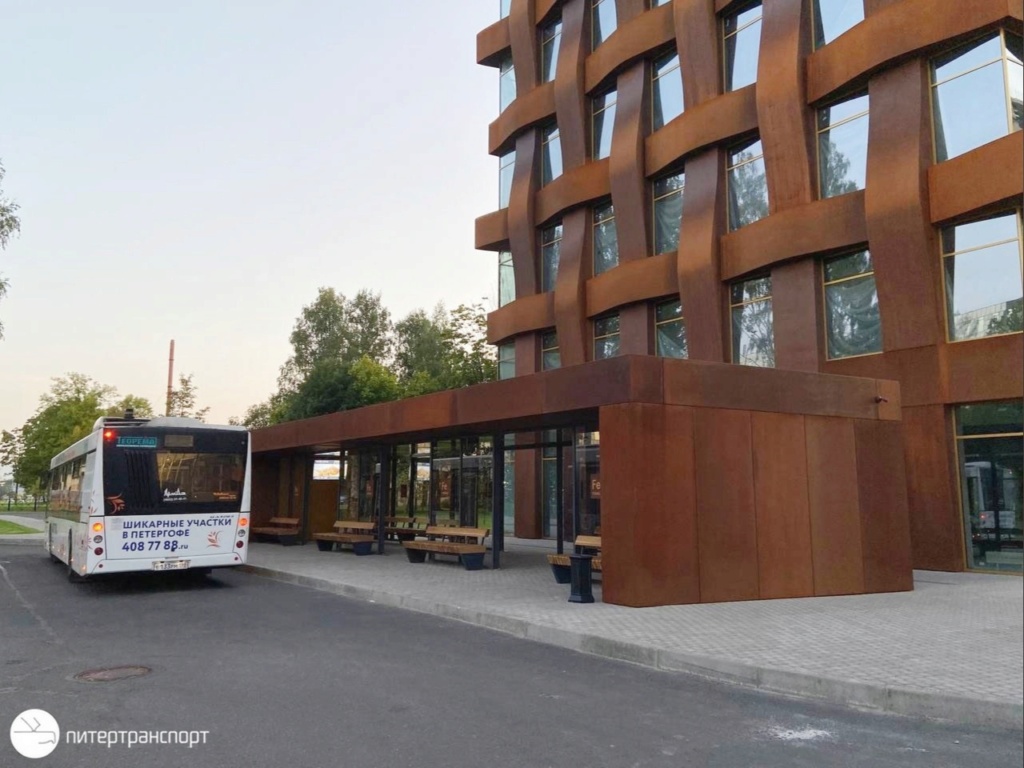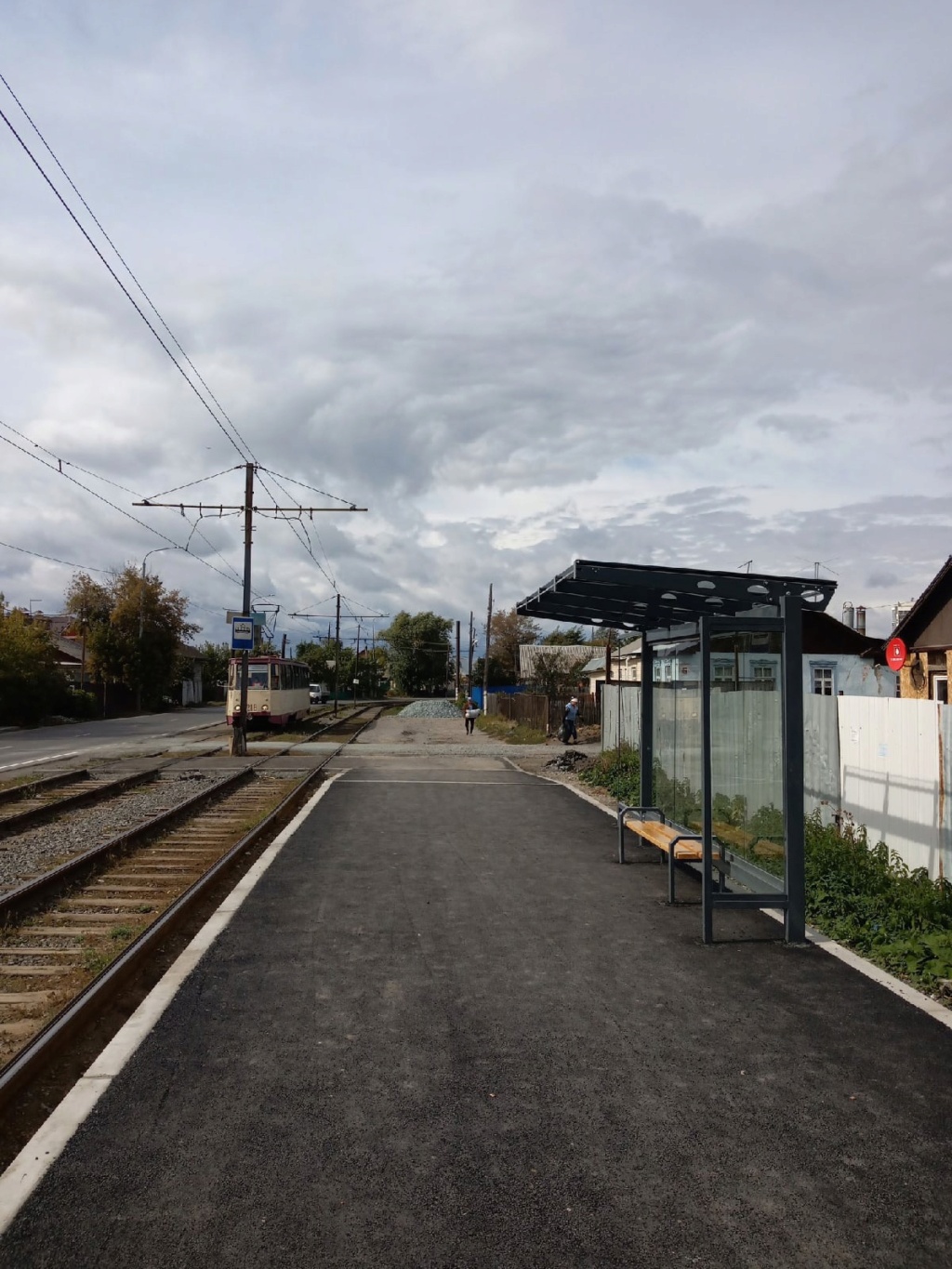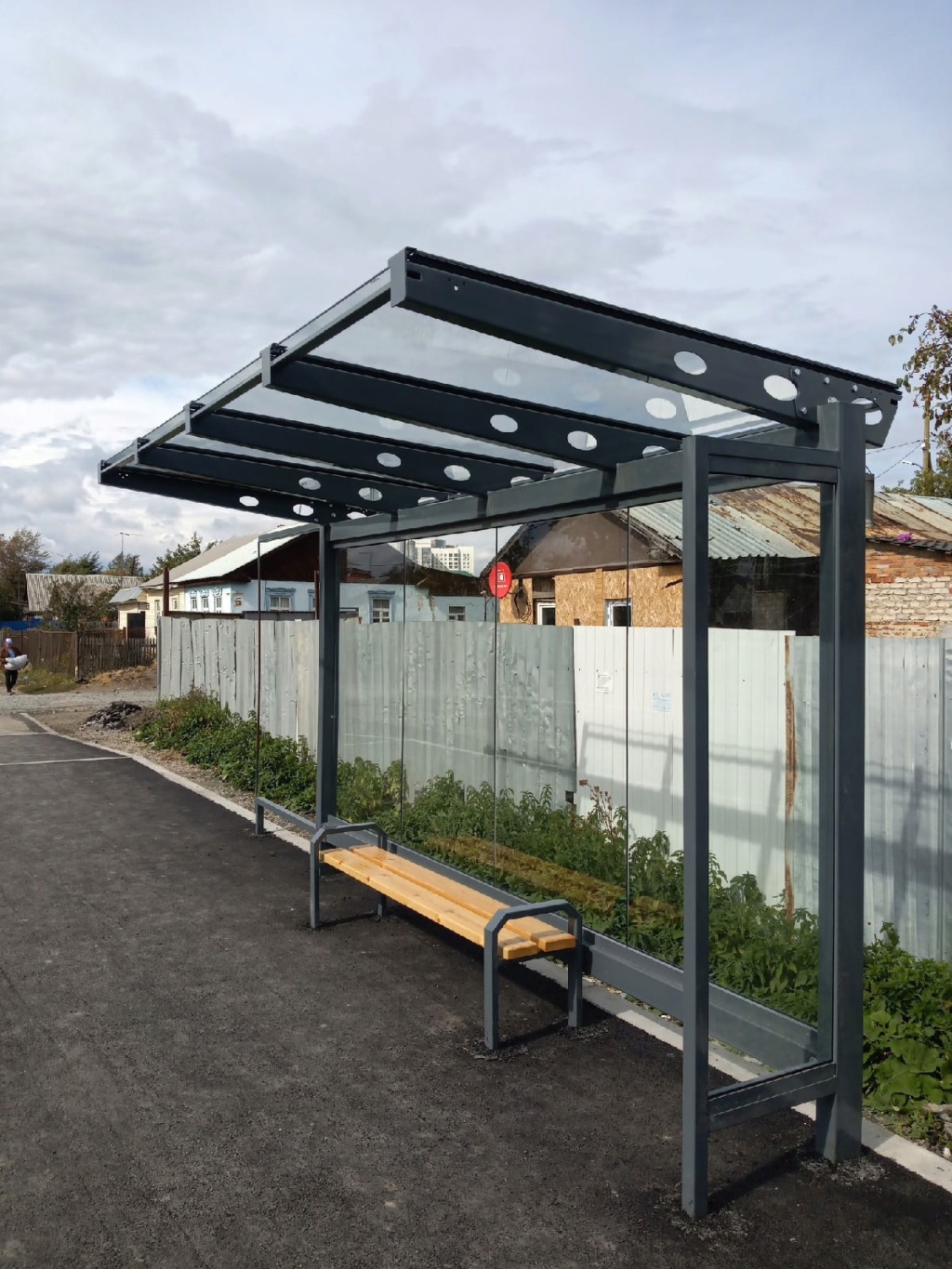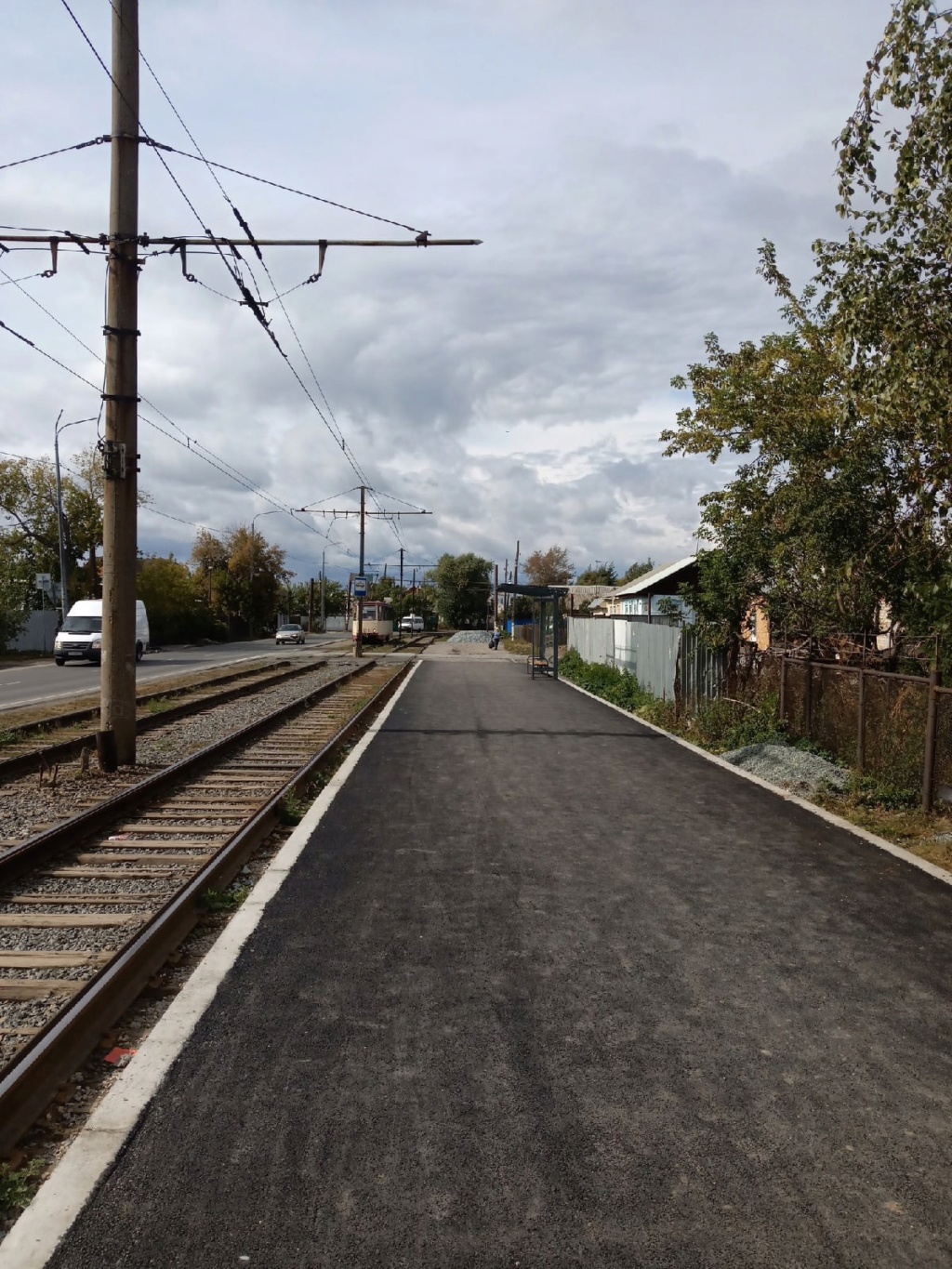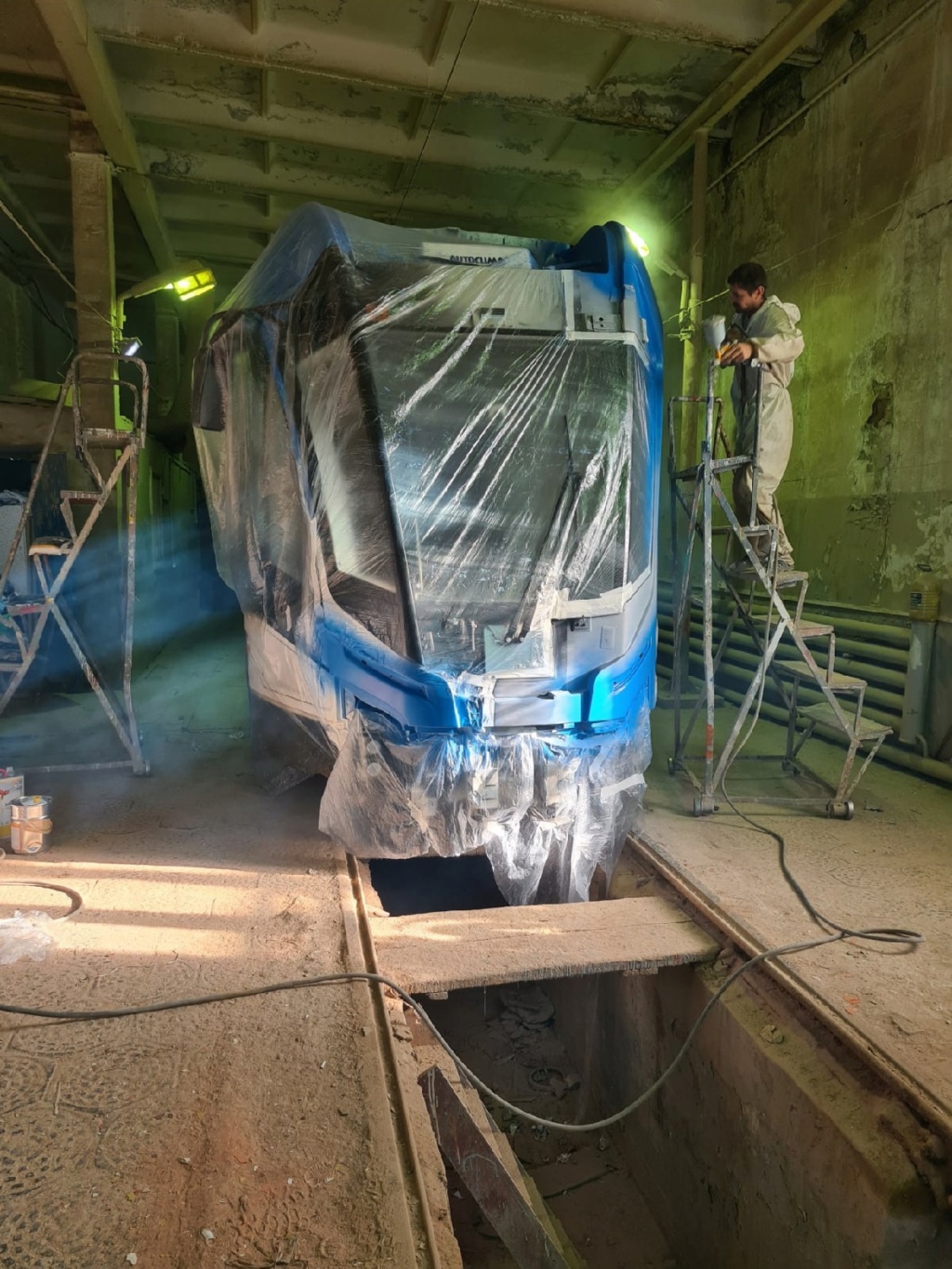+7
Kiko
kvs
Russian_Patriot_
Big_Gazza
ALAMO
GarryB
flamming_python
11 posters
Public transport in Russian cities

Russian_Patriot_- Posts : 1286
Points : 1300
Join date : 2021-06-08
- Post n°101
 Re: Public transport in Russian cities
Re: Public transport in Russian cities

Russian_Patriot_- Posts : 1286
Points : 1300
Join date : 2021-06-08
- Post n°102
 Re: Public transport in Russian cities
Re: Public transport in Russian cities

Russian_Patriot_- Posts : 1286
Points : 1300
Join date : 2021-06-08
- Post n°103
 Re: Public transport in Russian cities
Re: Public transport in Russian cities
A new electric bus from LiAZ (GAZ Group) – E-Citymax 12.
This is a new generation electric bus of a large class. The model is equipped with Microwast batteries of the NMC type with a capacity of up to 350 kWh, which provide an increased power reserve of up to 200 km on a single charge. The E-Citymax 12 electric bus has the ability to charge batteries in three ways: ultra-fast pantograph in 1.5 hours, fast pistol in 2.5 hours and night in 7 hours. The batteries are equipped with an autonomous temperature control system, which automatically cools the batteries in summer and warms them up to the optimal operating temperature in winter, which allows you to stabilize the power reserve of the electric bus throughout the entire battery life. The total passenger capacity of the E-Citymax 12 is 85 passengers, there are 36 seats and a place for a wheelchair. The novelty received an independent suspension, which provides better smoothness on roads with poor coverage. The E-Citymax 12 bus will be produced at the Likinsky Bus Plant of GAZ Group.

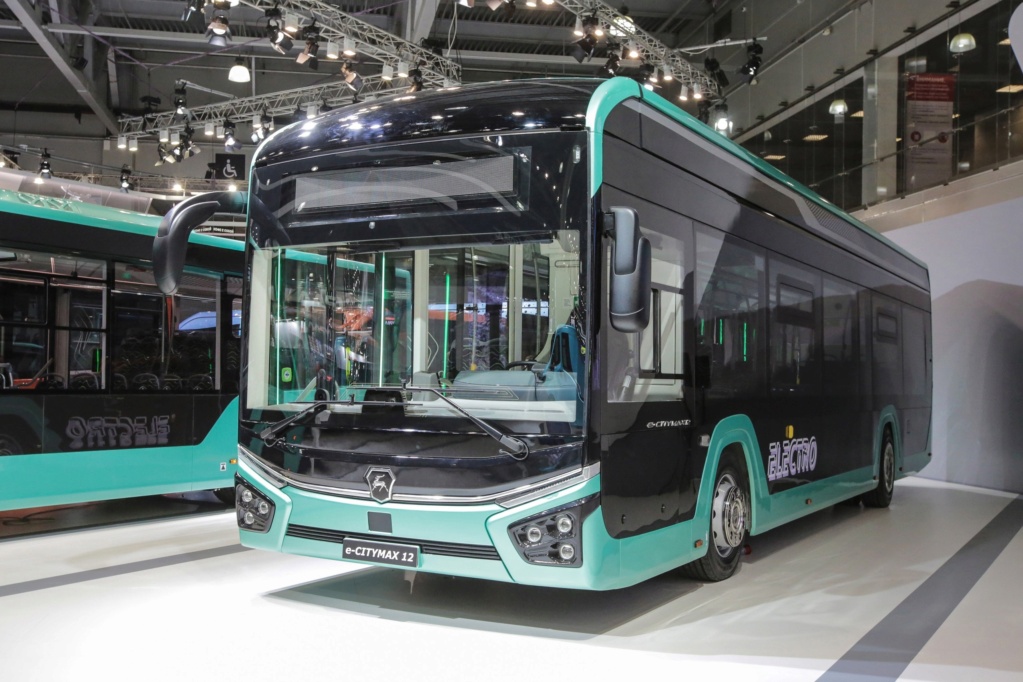
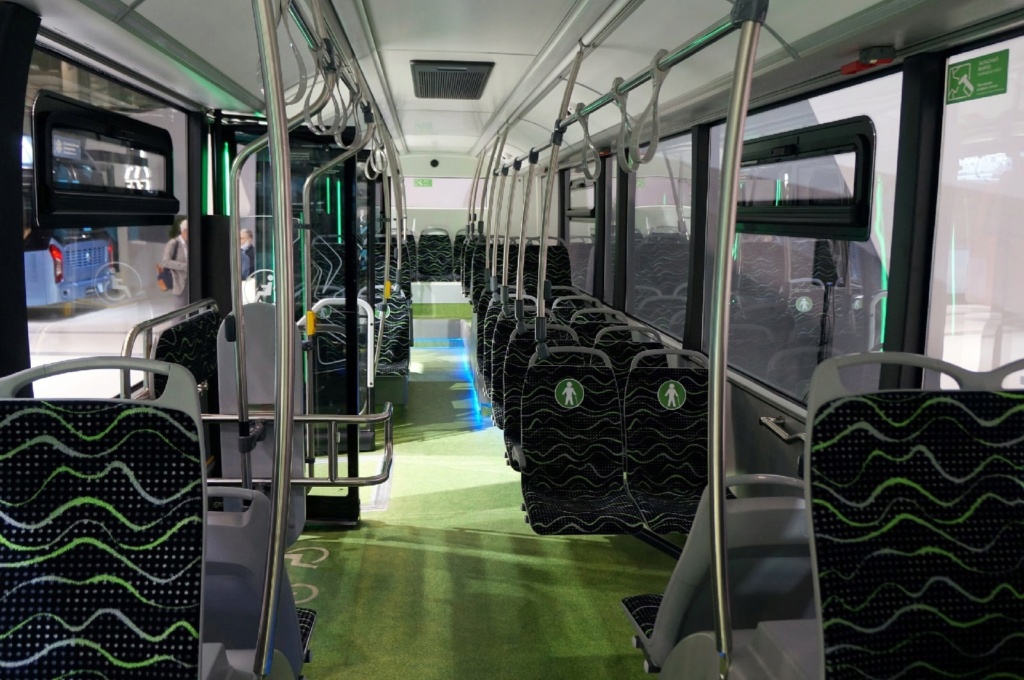

This is a new generation electric bus of a large class. The model is equipped with Microwast batteries of the NMC type with a capacity of up to 350 kWh, which provide an increased power reserve of up to 200 km on a single charge. The E-Citymax 12 electric bus has the ability to charge batteries in three ways: ultra-fast pantograph in 1.5 hours, fast pistol in 2.5 hours and night in 7 hours. The batteries are equipped with an autonomous temperature control system, which automatically cools the batteries in summer and warms them up to the optimal operating temperature in winter, which allows you to stabilize the power reserve of the electric bus throughout the entire battery life. The total passenger capacity of the E-Citymax 12 is 85 passengers, there are 36 seats and a place for a wheelchair. The novelty received an independent suspension, which provides better smoothness on roads with poor coverage. The E-Citymax 12 bus will be produced at the Likinsky Bus Plant of GAZ Group.





Russian_Patriot_- Posts : 1286
Points : 1300
Join date : 2021-06-08
- Post n°104
 Re: Public transport in Russian cities
Re: Public transport in Russian cities
Last edited by Russian_Patriot_ on Tue Sep 07, 2021 5:47 pm; edited 1 time in total

Russian_Patriot_- Posts : 1286
Points : 1300
Join date : 2021-06-08
- Post n°105
 Re: Public transport in Russian cities
Re: Public transport in Russian cities
New hydrogen buses from GAZ Group:
The Citymax Hydrogen large-class water bus is developed on the platform of the GAZ electric bus, which is mass-produced at the Likinsky Bus Plant.
The Citymax Hydrogen design uses a domestic electronic control system for a hydrogen power plant developed by the A.A. Lipgart Engineering Center, which was created by GAZ Group together with the Bauman Moscow State Technical University.
Citymax Hydrogen is an urban low-floor bus designed to carry 85 passengers.
It is equipped with modern on-board security and driver assistance systems: traffic blocking in the absence of a driver and open doors, video surveillance cameras with a 360-degree view, a driver status monitoring system.
A multiplex system is installed in the vehicle, which monitors the parameters of the bus in online mode and transmits data to the transport fleet.
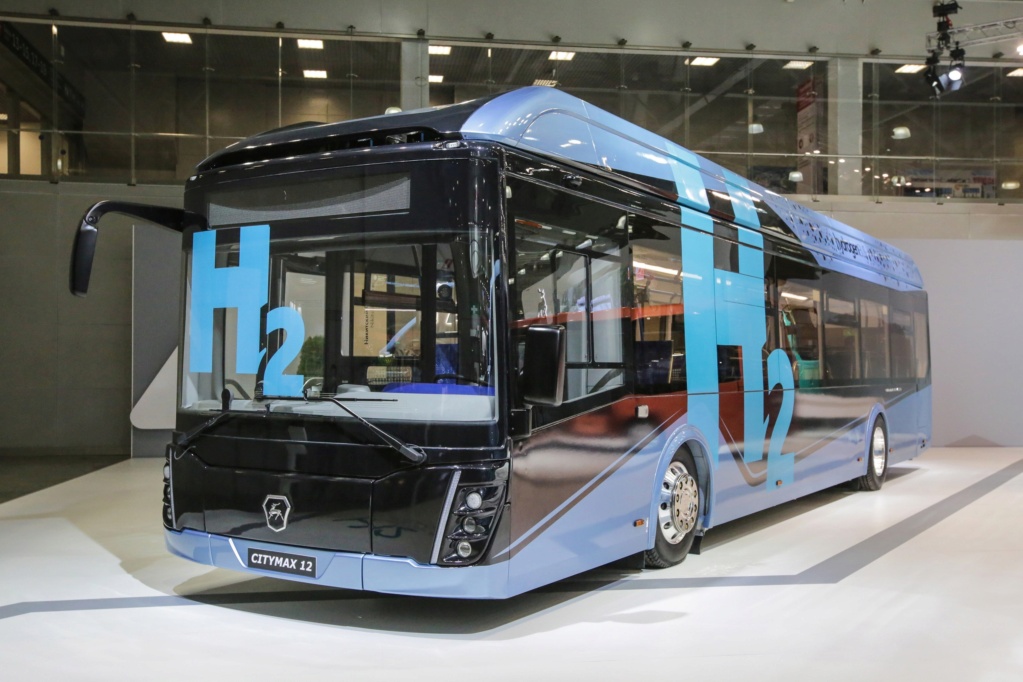
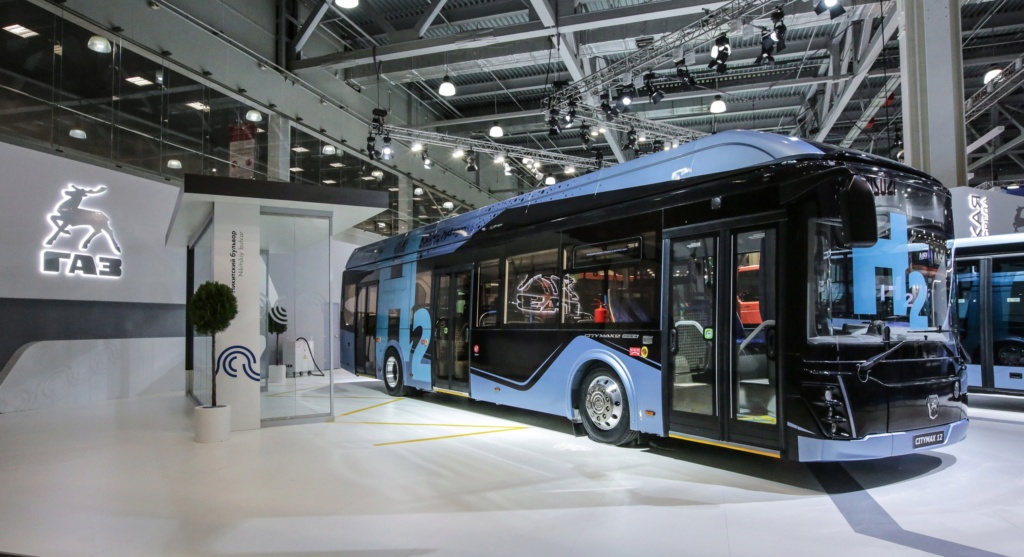
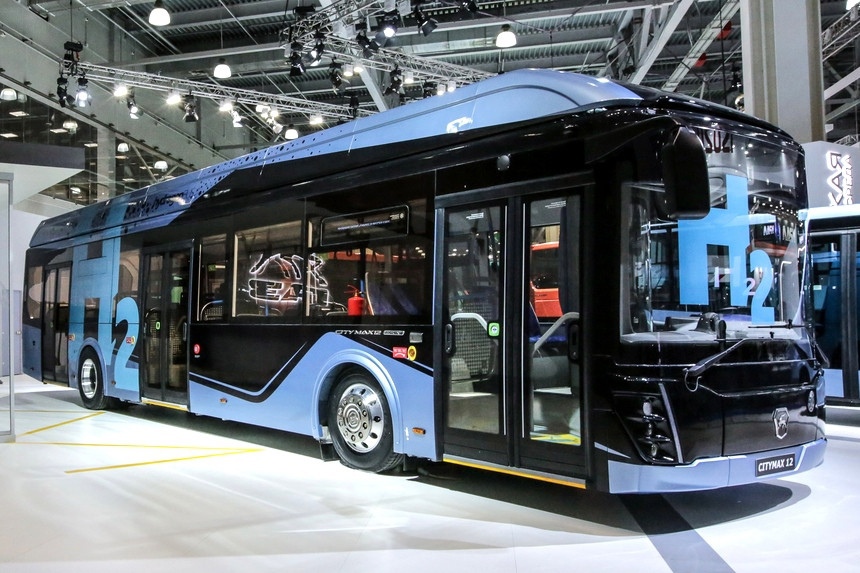
The GAZelle City hydrogen bus is developed on the basis of a small class bus, mass-produced at the Gorky Automobile Plant. The bus is designed to carry 22 passengers. The model is designed in accordance with the requirements of the "Accessible Environment" program and provides a high level of comfort, including the convenience of entry/exit for passengers with limited mobility. The distinctive features of the minibus are a low floor level, a storage platform for passengers in the central part of the cabin, a wide double door with an electric drive. The model is equipped with an air suspension, which provides an additional lowering of the floor to the level of the curb. Additionally, a folding ramp is provided for the entry of a wheelchair or a baby carriage into the salon.
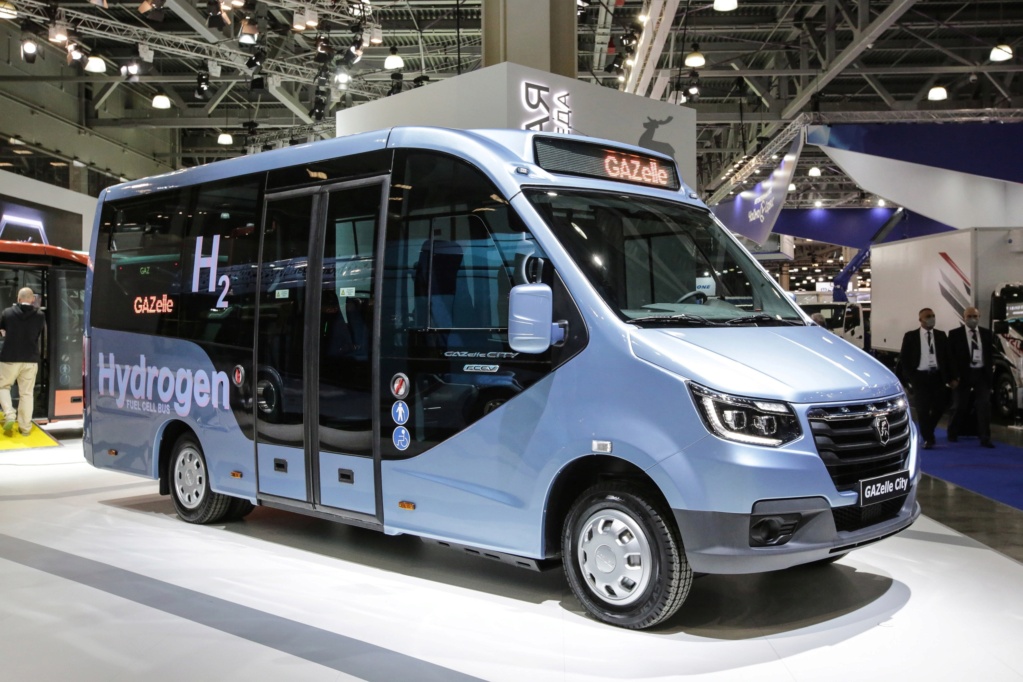

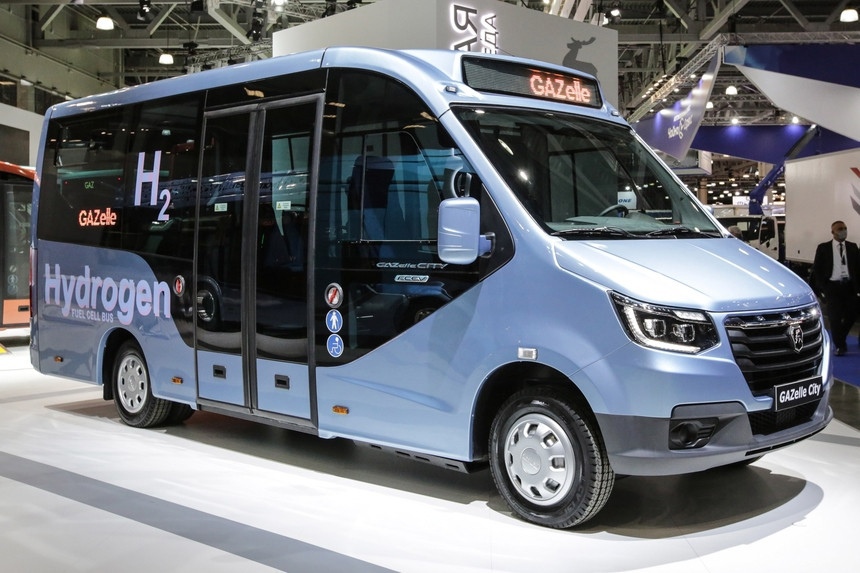
The advantage of hydrogen buses developed by GAZ Group is the possibility of additional charging from the electric network for traveling on part of the route where there is no hydrogen refueling.
The Citymax Hydrogen large-class water bus is developed on the platform of the GAZ electric bus, which is mass-produced at the Likinsky Bus Plant.
The Citymax Hydrogen design uses a domestic electronic control system for a hydrogen power plant developed by the A.A. Lipgart Engineering Center, which was created by GAZ Group together with the Bauman Moscow State Technical University.
Citymax Hydrogen is an urban low-floor bus designed to carry 85 passengers.
It is equipped with modern on-board security and driver assistance systems: traffic blocking in the absence of a driver and open doors, video surveillance cameras with a 360-degree view, a driver status monitoring system.
A multiplex system is installed in the vehicle, which monitors the parameters of the bus in online mode and transmits data to the transport fleet.



The GAZelle City hydrogen bus is developed on the basis of a small class bus, mass-produced at the Gorky Automobile Plant. The bus is designed to carry 22 passengers. The model is designed in accordance with the requirements of the "Accessible Environment" program and provides a high level of comfort, including the convenience of entry/exit for passengers with limited mobility. The distinctive features of the minibus are a low floor level, a storage platform for passengers in the central part of the cabin, a wide double door with an electric drive. The model is equipped with an air suspension, which provides an additional lowering of the floor to the level of the curb. Additionally, a folding ramp is provided for the entry of a wheelchair or a baby carriage into the salon.



The advantage of hydrogen buses developed by GAZ Group is the possibility of additional charging from the electric network for traveling on part of the route where there is no hydrogen refueling.

Russian_Patriot_- Posts : 1286
Points : 1300
Join date : 2021-06-08
- Post n°106
 Re: Public transport in Russian cities
Re: Public transport in Russian cities
The KAMAZ-6290 hydrogen electric bus was presented at Comtrans-2021. The design documentation for the prototype of a hydrogen electric bus was developed taking into account the technical requirements for electric buses, that is, the KAMAZ-6282 electric bus, which is delivered to Moscow, was taken as the base. However, unlike an electric bus, the KAMAZ water bus can travel 250 kilometers after the batteries are fully charged, which makes it suitable even for long-distance communication.
However, unlike an electric bus, the KAMAZ hydrogen bus can travel 250 kilometers after the batteries are fully charged, which makes it suitable even for long-distance communication.
The total weight of the hydrogen electric bus is 19 tons, its overall dimensions are 12.4 2.55 3.4 meters. The novelty is powered by hydrogen fuel cells and is equipped with six cylinders for storing compressed hydrogen. For safety reasons, the cylinders are installed on the roof: in the event of a leak, the hydrogen will go up, and not into the cabin.
"In 2022, we intend to test a prototype of a KAMAZ hydrogen electric bus on the streets of Moscow, in real operating conditions. They will be completed, approximately, in 2023. In the event of the creation of an appropriate refueling infrastructure and demand for a new type of ecotransport from Moscow, we plan to organize the final assembly of hydrogen electric buses on the territory of the Sokolniki Car Repair and Construction Plant in the capital, where KAMAZ electric buses are already being successfully assembled" – said Andrey Savinkov, Deputy Chief Designer of KAMAZ PJSC, chief car designer.

However, unlike an electric bus, the KAMAZ hydrogen bus can travel 250 kilometers after the batteries are fully charged, which makes it suitable even for long-distance communication.
The total weight of the hydrogen electric bus is 19 tons, its overall dimensions are 12.4 2.55 3.4 meters. The novelty is powered by hydrogen fuel cells and is equipped with six cylinders for storing compressed hydrogen. For safety reasons, the cylinders are installed on the roof: in the event of a leak, the hydrogen will go up, and not into the cabin.
"In 2022, we intend to test a prototype of a KAMAZ hydrogen electric bus on the streets of Moscow, in real operating conditions. They will be completed, approximately, in 2023. In the event of the creation of an appropriate refueling infrastructure and demand for a new type of ecotransport from Moscow, we plan to organize the final assembly of hydrogen electric buses on the territory of the Sokolniki Car Repair and Construction Plant in the capital, where KAMAZ electric buses are already being successfully assembled" – said Andrey Savinkov, Deputy Chief Designer of KAMAZ PJSC, chief car designer.


Russian_Patriot_- Posts : 1286
Points : 1300
Join date : 2021-06-08
- Post n°107
 Re: Public transport in Russian cities
Re: Public transport in Russian cities
The creation of tram traffic on the Vostochny will require 33 billion rubles.
Roscosmos plans to invest more than 33 billion rubles together with its partners to develop high-speed tram traffic at the Vostochny Cosmodrome and in nearby settlements. This is stated in the concept of the development of the tram infrastructure of the Amur region, available to TASS.
"The volume of investments is 33.3 billion rubles (31.8 billion rubles - capital expenditures, 1.5 billion rubles-rolling stock)" – the concept says.
According to the document, the investments will be equally divided between Roscosmos (together with an external investor), the Amur Region and Gazprom. At the moment, the possibility of reducing the cost of the project is being worked out.
According to the plan, tram traffic should connect the Vostochny cosmodrome with the Tsiolkovsky Airport, the airport under construction there, the cities of Svobodny and Shimanovsk, as well as with the Amur Gas Processing Plant. The projected passenger traffic is 5 million people per year.
At the beginning of February last year, the general director of the Ust-Katavsky Car Building Plant (UKVZ, part of Roscosmos), Roman Novikov, announced that a preliminary agreement had been reached on the organization of tram traffic at the Vostochny cosmodrome. According to him, modern five-section, low-floor tram cars will be used to transport people.
As the UKVZ later clarified to TASS, all trams will be of a new generation, including the planned use of unmanned technologies.
Source:
Roscosmos plans to invest more than 33 billion rubles together with its partners to develop high-speed tram traffic at the Vostochny Cosmodrome and in nearby settlements. This is stated in the concept of the development of the tram infrastructure of the Amur region, available to TASS.
"The volume of investments is 33.3 billion rubles (31.8 billion rubles - capital expenditures, 1.5 billion rubles-rolling stock)" – the concept says.
According to the document, the investments will be equally divided between Roscosmos (together with an external investor), the Amur Region and Gazprom. At the moment, the possibility of reducing the cost of the project is being worked out.
According to the plan, tram traffic should connect the Vostochny cosmodrome with the Tsiolkovsky Airport, the airport under construction there, the cities of Svobodny and Shimanovsk, as well as with the Amur Gas Processing Plant. The projected passenger traffic is 5 million people per year.
At the beginning of February last year, the general director of the Ust-Katavsky Car Building Plant (UKVZ, part of Roscosmos), Roman Novikov, announced that a preliminary agreement had been reached on the organization of tram traffic at the Vostochny cosmodrome. According to him, modern five-section, low-floor tram cars will be used to transport people.
As the UKVZ later clarified to TASS, all trams will be of a new generation, including the planned use of unmanned technologies.
Source:
GarryB and flamming_python like this post

Russian_Patriot_- Posts : 1286
Points : 1300
Join date : 2021-06-08
- Post n°108
 Re: Public transport in Russian cities
Re: Public transport in Russian cities
PapaDragon likes this post

Russian_Patriot_- Posts : 1286
Points : 1300
Join date : 2021-06-08
- Post n°109
 Re: Public transport in Russian cities
Re: Public transport in Russian cities
Mishustin supported the development of a high-speed tram line in Saratov.
Russian Prime Minister Mikhail Mishustin supported the development strategy of the high-speed tram line in Saratov. He said this during a trip to this city, visiting the Kirov tram depot.
As Roman Busargin, Vice-governor and Chairman of the Government of the Saratov Region, told the prime Minister, the current state of the Saratov tram tracks does not allow increasing the quality of transportation - the speed of trams is 10 km/h, while on the high-speed line this indicator will reach 30 km/h. According to him, the total amount of investments for the modernization of electric and rail facilities will amount to 9.3 billion rubles for three years, and passenger traffic will be increased from 21 to 32 million people per year by 2029. Busargin asked Mishustin to support the project.
"First of all, we are talking about a major modernization of the entire public transport infrastructure, which the president spoke about in his address. This is a very serious, systemic, large project that will allow people to get modern technological means of transportation. I will say right away, this is a wonderful pilot project that has been worked on for quite a long time <...> It will be supported" – Mishustin replied.
The Prime Minister added that the necessary funds have been allocated to the budget for updating the public transport infrastructure, and a set of socio-economic initiatives is also provided. "It is very important that in this story we were able to change the infrastructure, make new normal adequate modern means of transportation and, first of all, provide people with reliable good transport" – he stressed.
In turn, the chairman of the State Duma Vyacheslav Volodin noted that the high - speed tram is a very important project for the city, since transport and rail facilities are so outdated that trams often derail. A single new route will connect several old routes, so "the whole city will be practically looped", which will speed up the movement of passengers.
Source:
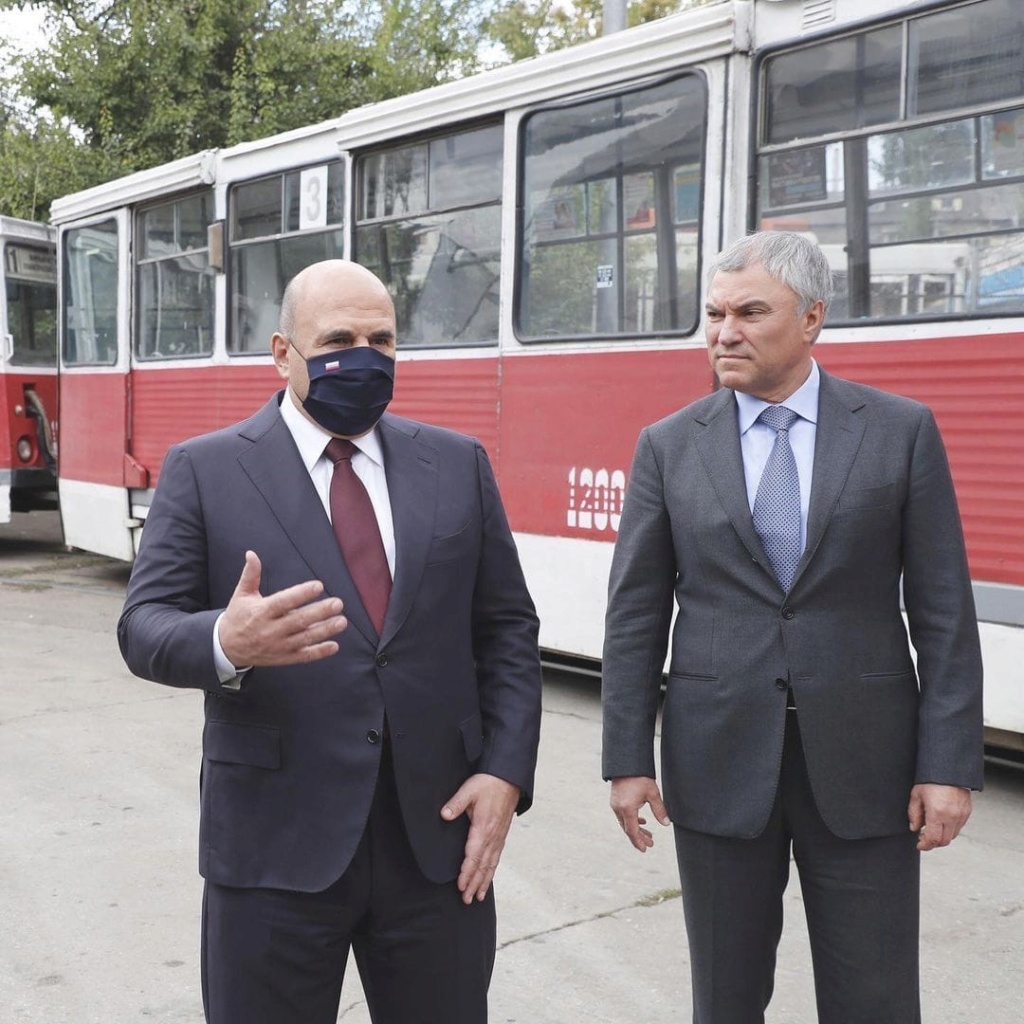



Russian Prime Minister Mikhail Mishustin supported the development strategy of the high-speed tram line in Saratov. He said this during a trip to this city, visiting the Kirov tram depot.
As Roman Busargin, Vice-governor and Chairman of the Government of the Saratov Region, told the prime Minister, the current state of the Saratov tram tracks does not allow increasing the quality of transportation - the speed of trams is 10 km/h, while on the high-speed line this indicator will reach 30 km/h. According to him, the total amount of investments for the modernization of electric and rail facilities will amount to 9.3 billion rubles for three years, and passenger traffic will be increased from 21 to 32 million people per year by 2029. Busargin asked Mishustin to support the project.
"First of all, we are talking about a major modernization of the entire public transport infrastructure, which the president spoke about in his address. This is a very serious, systemic, large project that will allow people to get modern technological means of transportation. I will say right away, this is a wonderful pilot project that has been worked on for quite a long time <...> It will be supported" – Mishustin replied.
The Prime Minister added that the necessary funds have been allocated to the budget for updating the public transport infrastructure, and a set of socio-economic initiatives is also provided. "It is very important that in this story we were able to change the infrastructure, make new normal adequate modern means of transportation and, first of all, provide people with reliable good transport" – he stressed.
In turn, the chairman of the State Duma Vyacheslav Volodin noted that the high - speed tram is a very important project for the city, since transport and rail facilities are so outdated that trams often derail. A single new route will connect several old routes, so "the whole city will be practically looped", which will speed up the movement of passengers.
Source:





Russian_Patriot_- Posts : 1286
Points : 1300
Join date : 2021-06-08
- Post n°110
 Re: Public transport in Russian cities
Re: Public transport in Russian cities

Russian_Patriot_- Posts : 1286
Points : 1300
Join date : 2021-06-08
- Post n°111
 Re: Public transport in Russian cities
Re: Public transport in Russian cities
GAZ made the new bus bigger than the "Gazelle", but smaller than the "Pazik".
A new city bus "Valdai City" is presented at the Comtrans exhibition that opened today in Moscow.
Last year, GAZ launched the production of the GAZelle City minibus, created on the basis of the truck of the same name. The new "Valdai City" was created according to the same recipe, but already on the chassis of the heavier "Valdai Next".
However, outwardly the original truck and buses are not similar: the "Valdai Next" has a cab without a hood, and the passenger "Valdai City" received the front part of the "GAZelle" cab. Under the hood is a Cummins ISF 2.8 turbodiesel with a capacity of 150 hp, which is traditional for gas equipment.
The new bus is larger than the GAZelle City, but more compact than the outdated Paziks: the car is designed to carry 32 passengers, there are 21 seats in the cabin. Other features of the model include a low floor, a wide door, an air suspension and a system for lowering one side at stops.
The official press release of GAZ Group does not indicate when it is planned to launch mass production of the Valdai City bus.
*Pazik - bus of PAZ brand
Source:
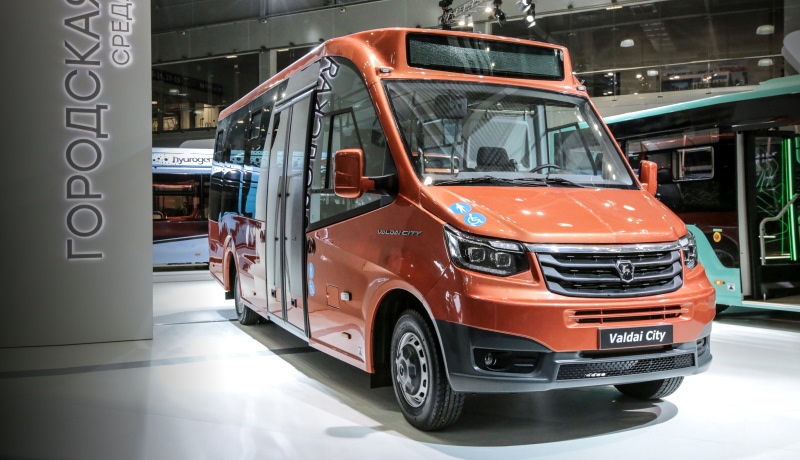
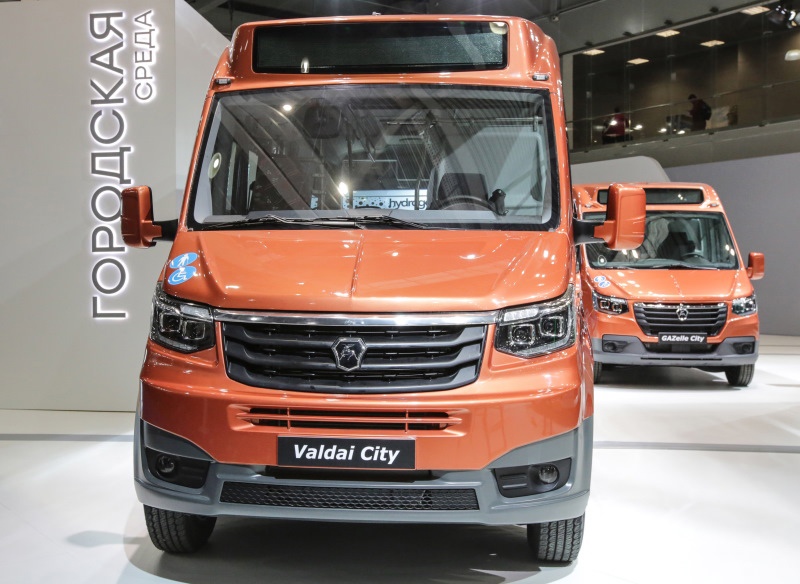
A new city bus "Valdai City" is presented at the Comtrans exhibition that opened today in Moscow.
Last year, GAZ launched the production of the GAZelle City minibus, created on the basis of the truck of the same name. The new "Valdai City" was created according to the same recipe, but already on the chassis of the heavier "Valdai Next".
However, outwardly the original truck and buses are not similar: the "Valdai Next" has a cab without a hood, and the passenger "Valdai City" received the front part of the "GAZelle" cab. Under the hood is a Cummins ISF 2.8 turbodiesel with a capacity of 150 hp, which is traditional for gas equipment.
The new bus is larger than the GAZelle City, but more compact than the outdated Paziks: the car is designed to carry 32 passengers, there are 21 seats in the cabin. Other features of the model include a low floor, a wide door, an air suspension and a system for lowering one side at stops.
The official press release of GAZ Group does not indicate when it is planned to launch mass production of the Valdai City bus.
*Pazik - bus of PAZ brand
Source:



Russian_Patriot_- Posts : 1286
Points : 1300
Join date : 2021-06-08
- Post n°112
 Re: Public transport in Russian cities
Re: Public transport in Russian cities

Russian_Patriot_- Posts : 1286
Points : 1300
Join date : 2021-06-08
- Post n°113
 Re: Public transport in Russian cities
Re: Public transport in Russian cities

Russian_Patriot_- Posts : 1286
Points : 1300
Join date : 2021-06-08
- Post n°114
 Re: Public transport in Russian cities
Re: Public transport in Russian cities

Russian_Patriot_- Posts : 1286
Points : 1300
Join date : 2021-06-08
- Post n°115
 Re: Public transport in Russian cities
Re: Public transport in Russian cities
There is a new thematic train on the Arbatsko-Pokrovskaya line – it is dedicated to the 800th anniversary of the birth of Prince Alexander Nevsky.
In the cars, you can learn everything about the Battle of the Neva in 1240, immerse yourself in the events of the Ice Battle that took place two years later.
And here you can also admire reproductions of Yemelyanov, Moler, Nesterov and many other great artists.
The thematic composition will run until March 2022.



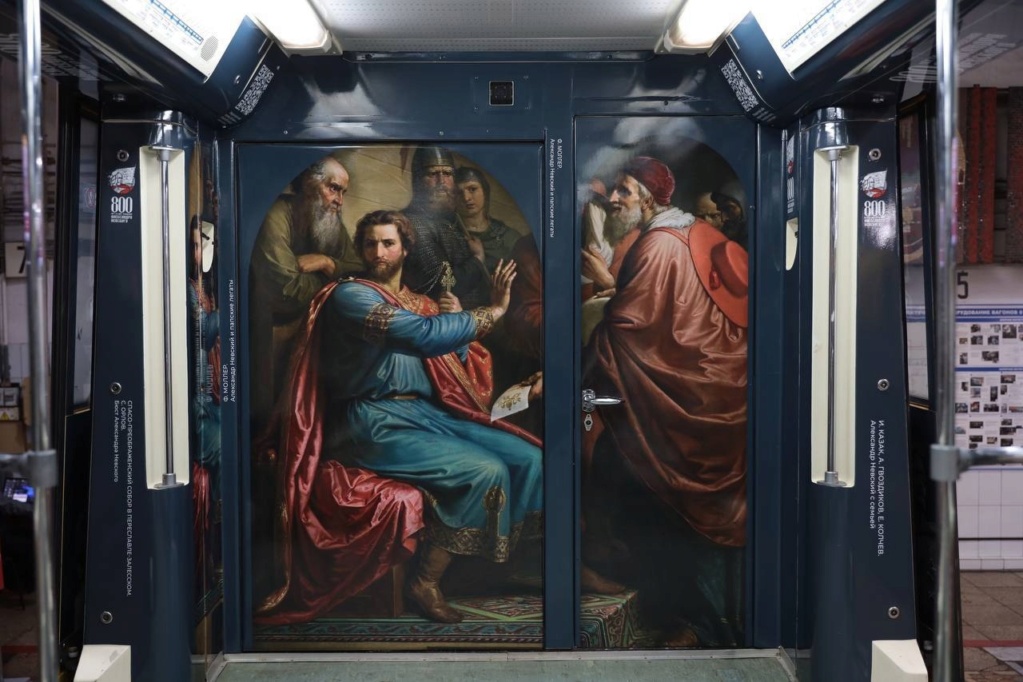
In the cars, you can learn everything about the Battle of the Neva in 1240, immerse yourself in the events of the Ice Battle that took place two years later.
And here you can also admire reproductions of Yemelyanov, Moler, Nesterov and many other great artists.
The thematic composition will run until March 2022.




GarryB and flamming_python like this post

Russian_Patriot_- Posts : 1286
Points : 1300
Join date : 2021-06-08
- Post n°116
 Re: Public transport in Russian cities
Re: Public transport in Russian cities
The hydrogen-fueled engine of the GAZelle City small class bus

Russian_Patriot_- Posts : 1286
Points : 1300
Join date : 2021-06-08
- Post n°117
 Re: Public transport in Russian cities
Re: Public transport in Russian cities
flamming_python and dino00 like this post

Russian_Patriot_- Posts : 1286
Points : 1300
Join date : 2021-06-08
- Post n°118
 Re: Public transport in Russian cities
Re: Public transport in Russian cities

miketheterrible- Posts : 7383
Points : 7341
Join date : 2016-11-06
- Post n°119
 Re: Public transport in Russian cities
Re: Public transport in Russian cities
Never stop posting Russian Patriot. I love your posts.
flamming_python and Russian_Patriot_ like this post

Russian_Patriot_- Posts : 1286
Points : 1300
Join date : 2021-06-08
- Post n°120
 Re: Public transport in Russian cities
Re: Public transport in Russian cities
dino00 likes this post

Russian_Patriot_- Posts : 1286
Points : 1300
Join date : 2021-06-08
- Post n°121
 Re: Public transport in Russian cities
Re: Public transport in Russian cities

Russian_Patriot_- Posts : 1286
Points : 1300
Join date : 2021-06-08
- Post n°122
 Re: Public transport in Russian cities
Re: Public transport in Russian cities
An industrial-style depot with a car wash and a recreation room will be built for trams in Verkhnyaya Pyshma.
The capital's investment company Movista Regions has approved a project plan for a depot for trams that will run on a new route between the cities of Yekaterinburg and Verkhnyaya Pyshma.
The building of the complex will consist of four floors, which will house technical and administrative premises. The production building will include, among other things, areas of daily and routine maintenance, repair of rolling stock, a car wash, a charging room for electric cars, a medical center and a rest room. The area of the built-up plot will be 2.25 hectares, and the building area of the production building will be 2438.6 sq. m.
The complex will not only be equipped with everything necessary for the operation of trams, but also create a modern look for the building: the depot will be built in an industrial style.
"The building is designed from modern materials and structures, using new technologies" – explains Alexander Sovetnikov, General Director of Movista Regions. – "The space and layout will be organized in such a way as to achieve maximum functionality and comfort for the depot employees when working anywhere in the building."
Source:

The capital's investment company Movista Regions has approved a project plan for a depot for trams that will run on a new route between the cities of Yekaterinburg and Verkhnyaya Pyshma.
The building of the complex will consist of four floors, which will house technical and administrative premises. The production building will include, among other things, areas of daily and routine maintenance, repair of rolling stock, a car wash, a charging room for electric cars, a medical center and a rest room. The area of the built-up plot will be 2.25 hectares, and the building area of the production building will be 2438.6 sq. m.
The complex will not only be equipped with everything necessary for the operation of trams, but also create a modern look for the building: the depot will be built in an industrial style.
"The building is designed from modern materials and structures, using new technologies" – explains Alexander Sovetnikov, General Director of Movista Regions. – "The space and layout will be organized in such a way as to achieve maximum functionality and comfort for the depot employees when working anywhere in the building."
Source:

George1 likes this post

Russian_Patriot_- Posts : 1286
Points : 1300
Join date : 2021-06-08
- Post n°123
 Re: Public transport in Russian cities
Re: Public transport in Russian cities
flamming_python likes this post

Russian_Patriot_- Posts : 1286
Points : 1300
Join date : 2021-06-08
- Post n°124
 Re: Public transport in Russian cities
Re: Public transport in Russian cities

Russian_Patriot_- Posts : 1286
Points : 1300
Join date : 2021-06-08
- Post n°125


